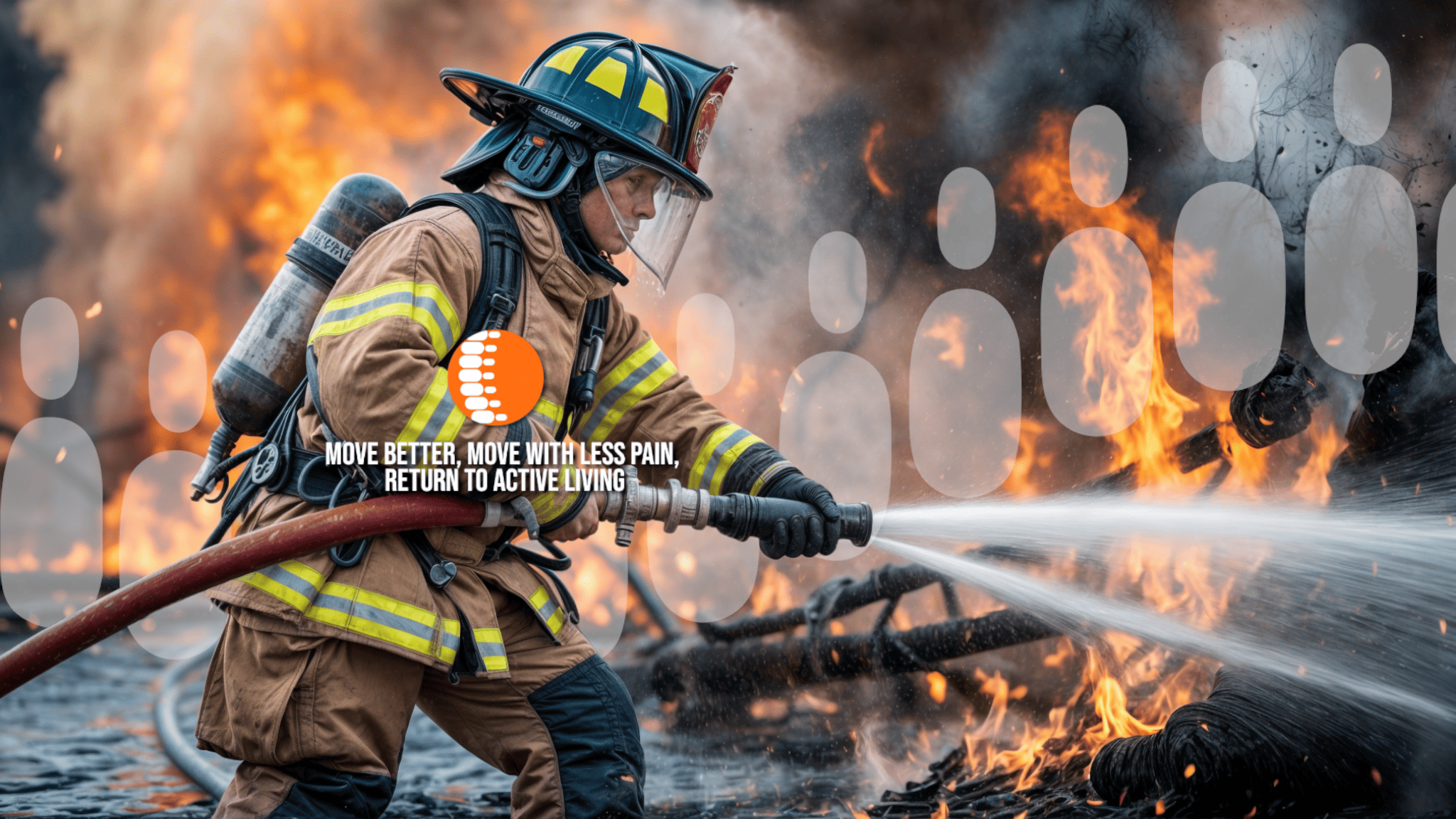Firefighters have an incredibly demanding profession, requiring strength, agility, and endurance. Every day, firefighters face extreme physical challenges—lifting heavy equipment, moving quickly in dangerous conditions, and enduring long hours in physically taxing situations. This constant strain puts them at high risk for musculoskeletal injuries (MSIs), which are a significant concern due to the physical demands of their job.

Key Statistics on Musculoskeletal Injuries (MSIs)
MSIs are prevalent among firefighters, with many reporting frequent symptoms and injuries related to overexertion. Here’s a breakdown of the key statistics:
- Occurrence Rate: Approximately 54% of firefighters report experiencing musculoskeletal symptoms (MSS) within a given week, with the most commonly affected areas being the back (32%), shoulders (24%), neck (19%), and knees (18%) (Nazari et al., 2020).
- Primary Causes: Overexertion and bodily reactions are the leading causes of MSIs, accounting for 54.1% of injuries (Le et al., 2020).
- Types of Injuries: Sprains and strains are the most common types of injuries, frequently resulting from slips, trips, falls, or lifting heavy objects (Orr et al., 2019). In the Durban Metropolitan Fire Department, low back injuries (47.9%) and strain injuries (40.8%) are the most prevalent types (Albert, 2009).
- Prevalence: The prevalence of MSIs among firefighters varies from 9% to 74% depending on factors like training intensity and personal health conditions (Orr et al., 2019).
- Economic Impact: MSIs are a leading cause of work absences and result in substantial economic costs. Firefighters are more likely to file workers’ compensation claims for MSIs compared to law enforcement officers and other workers, with about 40% of these claims related to MSIs (Anderson et al., 2023).
With such a high rate of occurrence and substantial physical and economic impact, it’s clear that firefighters must prioritize injury prevention and recovery strategies. Chiropractic care and athletic therapy offer effective, non-invasive solutions for managing and preventing MSIs.
Lindsey’s Story: A Journey of Recovery and Resilience
Lindsey Ingram, a firefighter and competitive athlete, knows the physical toll of such demanding roles. After knee surgery in 2010, Lindsey faced a tough recovery. However, with chiropractic care, she not only returned to work but also came back stronger than ever.
“I’ve been treated by Dr. Notley for a couple of years now. With my sports and job demands, I need to be at my best. Dr. Notley ensures I am. After my knee surgery in 2010, I had a breakthrough competitive season, thanks to Dr. Notley’s support.”
In 2011, Lindsey achieved impressive results, including:
- 2nd place, team firefighter division, stair climb race, Dallas TX
- 2nd place, La Coupe Olympic weightlifting competition
- 2nd place, tall and masters categories, MABBA figure novice show
- 1st place, age group St. Malo triathlon
- 8th place, age group Warrior Dash Minnesota (36th overall)
- 7th place, age group National triathlon championships
- 1st place, Regional Firefit competition
- 2nd place, National Firefit competition
- 3rd place, World Firefighter Combat Challenge
- 3rd place, co-ed tandem World Firefighter Combat Challenge
Her story underscores the importance of proper care and recovery, not only for athletes but also for those in physically demanding jobs.
The Power of Combining Chiropractic Care and Athletic Therapy for Firefighters
Firefighters face intense physical challenges, making effective injury prevention and rehabilitation essential. Combining chiropractic care with athletic therapy offers a comprehensive approach to maintaining musculoskeletal health and enhancing performance.
Chiropractic care and athletic therapy work together seamlessly. Chiropractic care improves spinal motion and reduces joint restrictions, crucial for managing pain and enhancing mobility. Adjustments relieve pain, increase flexibility, and maintain joint health, all vital for firefighters.
Conversely, athletic therapy uses manual therapy, targeted exercises, and functional conditioning to strengthen weak or injured areas. This proactive approach improves strength and flexibility and prepares firefighters for their unique physical demands. It speeds up recovery and lowers future injury risks.
Lindsey Ingram’s success highlights this synergy. Her recovery and ongoing performance are a testament to how combining chiropractic care and athletic therapy can aid in recovery and support physical readiness, ensuring firefighters stay resilient and perform at their best.
Lindsey’s Journey Back to Strength
Chiropractic care has been key to Lindsey’s recovery and success. Post-surgery, Dr. Notley’s treatment played a crucial role in her return to competitive level. Her story is a powerful reminder of the importance of prioritizing musculoskeletal health for long-term performance.
Take Action on Injury Prevention and Recovery
For firefighters, athletes, or anyone in a physically demanding role, staying proactive about musculoskeletal health is vital. Chiropractic and athletic therapy can expedite recovery, prevent future injuries, and enhance performance. With proper care, overcoming injuries and excelling in your profession is achievable.
If you need more information or treatment, don’t hesitate to reach out to a professional who can create a recovery plan based on your specific needs.
Winnipeg Chiropractor and Athletic Therapist
Originally posted on May 17, 2022 @ 4:36 pm
